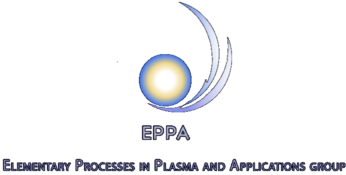Research Areas
- Thin film and layer deposition with Thermionic Vacuum Arc Technology (TVA).
- Thin film and layer deposition using magnetron sputtering techniques, such as DC, HiPIMS, HiPIMS-BP and RF.
- Development of thin layers for the study of plasma-wall interaction in a thermonuclear fusion reactor.
- Development of Be and mixed Be-based layers ( Be-W, Be-C, Be-O, Be-N, Be-Ne) with controlled deuterium and impurity content for nuclear fuel retention studies.
- Study of nuclear fuel desorption Kinematics from Be and mixed Be-based layers using Thermal Desorption Spectroscopy (TDS) measurements.
- Sectioning and post-mortem analysis of first-wall and divertor components extracted from the JET-ILW fusion reactor
- Development of coatings with tribological, antibacterial and anti-corrosive coatings with applications in the industry
List of Services
Thin film coatings using Reactive Magnetron Sputtering
Available in two different configurations: Direct Current Magnetron Sputtering and High Power Impulse Magnetron Sputtering, these techniques are employed for the sputtering of metallic and insulator targets. Also sputtering metallic targets in the presence of reactive gas makes it possible to form compound layers such as nitrides, oxides, carbides and their combination.
Thin film coatings using TVA (Thermionic Vacuum Arc) deposition technique used for the deposition sample and composite thin films (up to three materials) in ultra-high vacuum conditions (10E-6 Torr) on a large range of substrates including thermal sensitive substrates. 0,1-10000 nm high purity, low roughness and very good adherence to the substrate of the deposited layers.
Thermal Desorprion Spectrometry measurements are used for the study of kinetic and thermodynamic parameters of desorption processes and decomposition reaction by heating a sample with an oven from room temperature to 1300K with a linear heating ramp betwen 0.1 and 15K/min and measuring in situ, the partial pressures of atoms and molecules released from materials by means of mass spectrometry.
Determination of friction coefficient and tribological properties of the materials using a ball on disk tribometer using a normal load 0-5N and programmable sliding distance and linear speed.
Plasma Treatment
In the Elementary Plasma Processes and Applications group we have an operational experimental setup that can perform various plasma treatments of surfaces and materials, including polymerizations. The setup was designed to monitor the variation of parameters, such as:
- Electrodes shapes
- Distance between electrodes (between 1 and 20cm)
- Distance between sample and electrodes
- Sample dimension up to Ø4”
- Gas ratios
- Plasma pressure from 10-3 to 10 mbar
- Type of plasma power supply
The gas is injected through the upper electrode to ensure an uniform distribution and rotation symmetry of the treatment. A robotic manipulator can change the position and angle of the samples inside the plasma chamber in respect to the electrodes and the gas flow. This can secure an uniform plasma treatment for samples with non-planar morphologies.
The plasma can be ignited and sustained by either commercial power sources (direct current and radio-frequency high voltage) or a home-made one (2kV, 10mA operating in pulses of (5 to 15) µs succeeding at a frequency repetition rate from 500Hz to 100kHz). These parameters insure a wide range of plasma characteristics such as different plasma densities, ion and electron energy distributions that can affect the desired outcome of the treatment.
